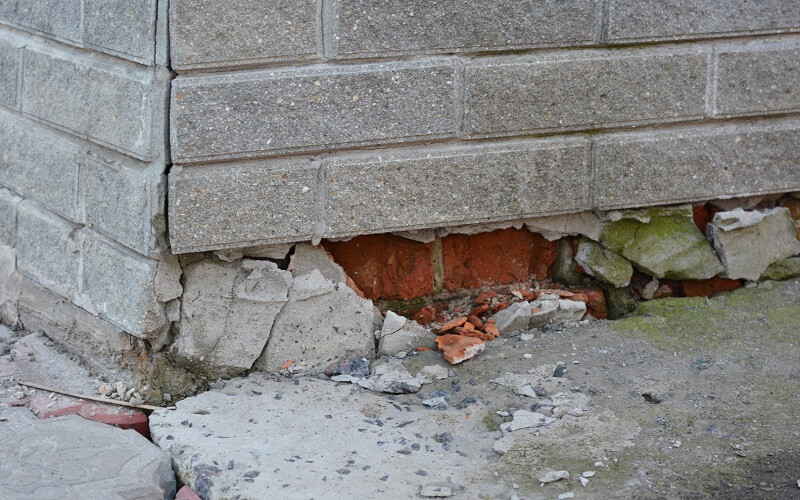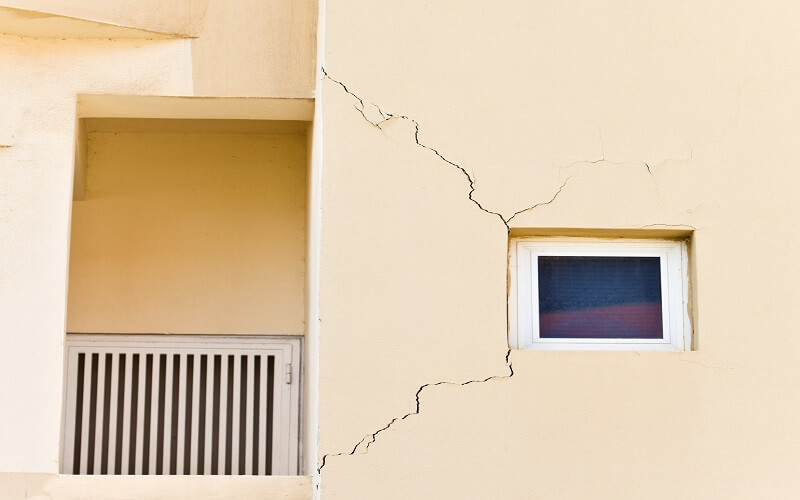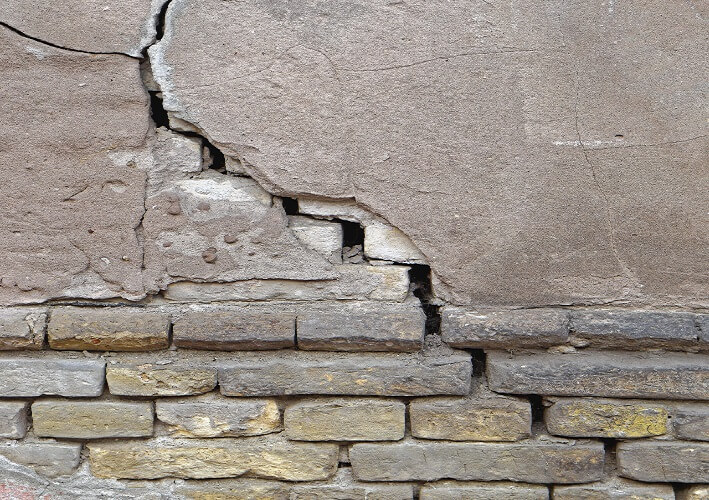Did you ever wonder if your house could sink? What about the Leaning Tower of Pisa? What exactly made it lean? Interestingly enough, it’s caused by house settling.
House Settling can be a daunting experience for a homeowner, especially if you have just moved to a new home.
Let’s examine the causes of house settling and provide solutions to this problem.
1- House Settling & Its Types
2- Causes of House Settling
3- Signs of House Settling
4- How Do I Fix
5- Foundation Problems VS Settling
6- Settling Cracks VS Foundation Cracks
7- Frequently Asked Questions
House settling can be defined as the gradual sinking of your house due to a shift or contraction in the soil beneath it. This happens over time because of factors such as soil, water, or earthquakes.
There are three different types of settling that could affect a house. These are:
Uniform – In a uniform, settling the foundation settles by an equal depth throughout the periphery of your home. This often doesn’t affect the structure or integrity of your house.
Tipping – An ideal example of tipping is the Leaning Tower of Pisa. Tippin happens when one side of the foundation settles more than the other leading to a tilt.
Differential – In differential settling, the foundation or support beneath your house experiences a heterogeneous sinking leading to a structural deformity and wide cracks. This can prove lethal for the integrity and structure of our home.
House settling can be caused by the soil beneath your house, a weak foundation, or too much moisture. Let’s examine these issues in more detail.

One of the prominent causes of house settling is the soil under the house. Soil settles over time, and this can cause your home to settle into it. Common factors include the density of soil, weight, and the amount of clay in the soil.
Soil having excess amounts of clay tends to settle more often because the clay can dry out, paving the way for compression. This is also called secondary compression,i.e., which occurs after the house is constructed.
Primary compaction with machinery or heavy equipment before building your house and checking the soil around it can help avoid settling due to soil.
Weather plays a huge role in house settling. As it changes, so does the soil underneath your home. When there is an increase in rain or snowfall, water seeps into the ground and creates a wet environment which can lead to the sinking of your home.
On the other hand, if climatic conditions become too hot and dry, the soil beneath the house loses its moisture and starts to compress.
Irregularities during the construction of the foundation can lead to house settling. Any gaps between the foundation and ground or large stones on top of the foundation often result in settling.
The houses built on sloping terrain or too close to each other settle more quickly than homes built on flat terrain or farther apart.
Concrete and wood are the most common construction materials used in houses. The material you use must be determined by the climate and geography of the location.
Wood is a common building material but is not as strong as concrete. It is also more susceptible to changes in temperature and humidity which can cause cracks in the house’s foundation over time.
Concrete is more robust than wood but tends to crack with time and with pressure from heavy objects. So the type of wood used and the concrete ratio must be as per the weight and climatic conditions around the house.
House settling can lead to slanted floors, door gaps, and cracks in the walls or ceilings. Let’s take a deeper look at the signs of house settling.

The first sign of settling is gaps between the windows and walls. As the house settles, the frames start to break away from the walls.
When installed, the doors are usually adjusted to fit snugly in their frames, but once settling kicks in, doors can become loose or even fall off their hinges.
Cracks in the foundation and floor are one of the most common signs of a house settling. In order to prevent water damage and termite entry, these cracks must be repaired immediately.
Burst water pipes are an indication that your home is settling. The sign cannot be considered accurate on its own and must be accompanied by a floor crack or vertical wall crack. This is because a burst pipe can occur for multiple reasons, such as water leakages, blockages, and corrosion.
With house settling, the floor starts to slant gradually. It might go unnoticed at first but can cause great trouble as it becomes more apparent later.
A slanted floor can also occur because of a shift in weight distribution that could be uneven on both sides of the foundation. This happens if other structures nearby or on the top of your home add additional weight but do not provide enough support to your home.
Another reason could be the rotting joints underneath the house.
Bowing walls is a common problem caused by a foundation shift or building settlement.
It’s a serious issue that can cause your house to slant or even collapse. It can also lead to problems, including cracks in the plaster, uneven floors, doors that won’t shut properly, and more.
Vertical wall cracks are a common occurrence with house settling. The cracks are usually seen outside a house, often at or near the foundation.
The best way of repairing settlement cracks is to remove any loose material around the hole, then fill it with concrete or mortar mix. You can also fill them with a self-leveling mixture that will create an even surface at the base of your foundation wall.
Here are the best ways to fix or prevent the house settling at the earliest stage.
Piers are used for supporting the foundation of the house. They work by transferring the weight of the house from the foundation to more stable ground.
These piers are installed at equal intervals, i.e., one or two feet apart, depending on how uneven the ground is. The spacing between them will depend on how far apart they need to be to transfer all the weight. They can be as close as possible without being in contact.

The first thing is to identify the location of the settlement. It’s done by using a laser level or a water level.
A stake is placed in the ground to measure how much it has sunk from its original height.
This helps determine how many piers will be needed for your house by dividing that number by 4. For example, if your home has sunk 3 inches, you’ll need six piers.
The most important thing about installing foundation piers is that they are not a permanent fix for settling houses. Still, it does provide some relief for homeowners who want to buy time before deciding on a more permanent solution.
Moisture can cause significant structural damage to a house. It can come from the ground or condensation inside the house. It is also a cause of non-structural damage like peeling paint, rotting wood, and mildew.
Moisture can be controlled from entering the house using a vapor barrier. A vapor barrier is used for dampproofing and is most commonly a plastic or foil sheet. It resists moisture diffusion through the building wall, floor, ceiling, or roof assemblies.
Ideally, a vapor barrier should be installed before the drywall and sealed to the floor and walls with a liquid-tight sealant, such as caulk or mastic. It should be installed in a continuous layer around all four walls, up to 6 feet from the floor.
But what if it has already penetrated your house? The first step is to find where it’s coming from. Look for damp spots on walls, floors, and ceilings with a flashlight in the evening when there isn’t too much natural light coming in through the windows.
Then fix whatever is causing the moisture problem, whether it’s a leaky pipe or an air conditioner that needs cleaning.
Finally, you can use dehumidifiers and fans to control humidity levels inside your home.
Adding floor supports to your house can help fix the problem of settling. Floor supports are structural components that support a house’s joists and subflooring. It can be built from wood, steel, or concrete and must be installed by professionals.
You need to identify the areas where settlement has taken place. This is done by using a level plumb line or a water level. It’s important to note that settlement will typically occur in the same areas over time, so it is worth checking these spots every few years.
If you have beams under the house, you’ll have to identify which beams are settling and then find out why they are settling. After considering these factors, floor supports can be added or replaced with new ones.
Once problem areas are identified, holes are drilled for your new floor supports. The size of the holes depends on the type of support you’re using – metal posts are usually 1-inch in diameter. At the same time, the concrete posts are usually 3/4-inch in diameter.
Floor Supports Can Include:
We have already discussed settling in length, but how is it different from a foundation problem? A foundation problem occurs due to extreme or differential house settling. It is often fatal for your home and can compromise its integrity and stability.

Two of the most common foundational problems are foundation expansion and shrinkage.
It is most common in homes that use bricks for their foundation. It’s the natural tendency of bricks to absorb moisture as they are exposed to the potentially damp soil underneath the ground.
Foundation shrinkage is a common problem with concrete. It can lead to visible gaps in the foundation along with the walls and pipes. A foundation shrinkage can often put the structure of the building at risk.
If you see cracks in the concrete, it’s essential to determine if those are house settling cracks or foundation cracks. Usually, settling cracks are small and don’t go all the way through the concrete.
On the other hand, foundation cracks are wider and deeper than settling cracks. It is often a vertical crack that starts at the top of the foundation and goes to the ground level. These cracks are usually caused by frost heaves or soil settlement and can be repaired by adding more concrete to the foundation.
House settling is a common phenomenon that can occur in most homes. It’s often not lethal but can lead to a complete mess.
With the methods and preventive techniques mentioned in this article, you can identify, avoid and take care of settling issues. However, I strongly advise you to contact a professional as soon as you identify any of the given signs associated with house settling.
Typically it happens within the first year, but it is impossible to predict when the house will settle, and there are no guarantees.
Settling is natural when a building is constructed on a new site. It happens because of the shrinkage and swelling of the materials that make up the building.
Some experts believe that a few inches (2 to 5 inches) of sinkage and wall cracks up to 1/10th of an inch are normal. It also depends on the type of settling. Is it uniform, tipping, or differential?
A uniform house settling does not cause much damage, but on the other hand, tipping or differential settling can cause major problems to the foundation of your house.
Houses settle because of the movement in soil occurring due to humidity, weather conditions, weak foundation, soil composition, and more. This movement can also be caused by earthquakes and excess weight on the foundation. Some other houses settle because they are built on a slope and do not have support from adjacent houses.
Yes, a house can settle after 20 years. Many factors contribute to the settling of a house- the type of soil and bedrock, the amount of moisture in the ground, the construction materials and techniques used, and the climate all play a role.
Moreover, if everything beneath the house is fine, a tectonic shift can cause it to settle even after 20 years.
House settling can be caused by too much foundation. This means too much uneven weight is on one side of the foundation. It can lead to cracks in walls and ceilings along with damaged doors and windows.
Related Article: